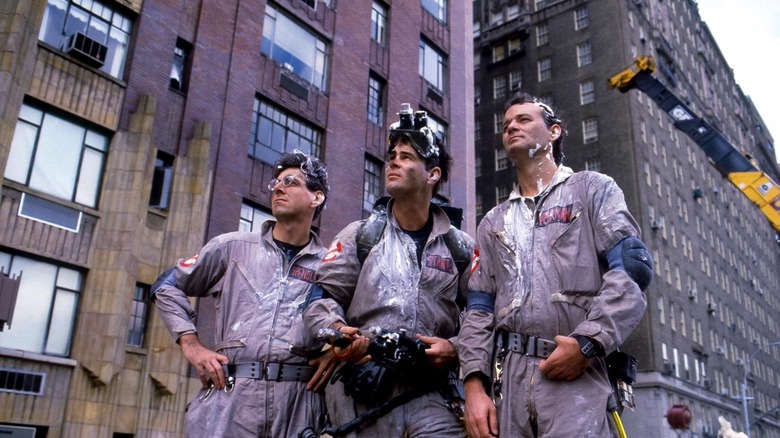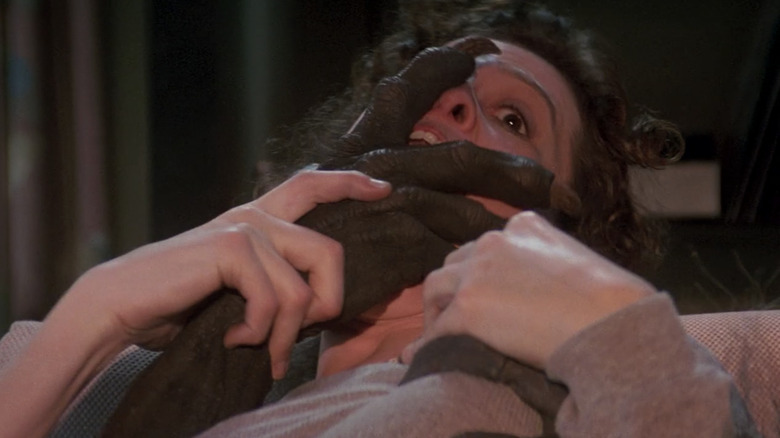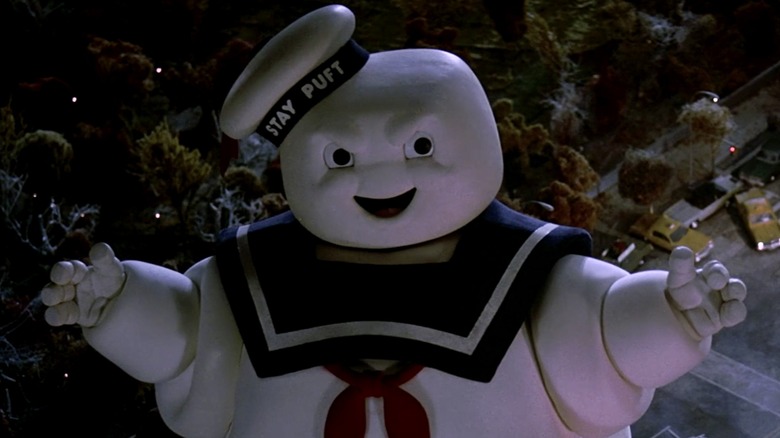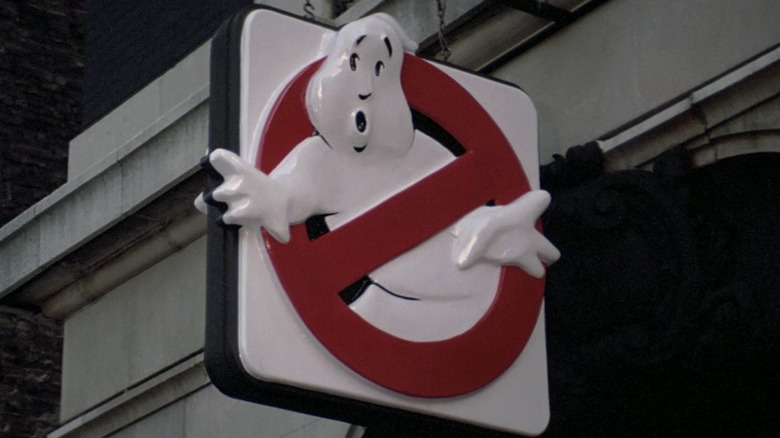
Ivan Reitman's passing came as an unexpected blow on Super Bowl night, as news of it broke amid the flood of usual movie marketing in primetime commercials. Just months ago, the Alamo Drafthouse dedicated its new Manhattan location to Reitman, and he was seen making the promotional rounds in other places for the recent legacy sequel, "Ghostbusters: Afterlife," which he produced and which his son, Jason Reitman, directed.
Reitman had a long career that yielded many beloved comedies, such as "Stripes" and "Dave," but he undoubtedly left his biggest imprint on pop culture with "Ghostbusters." It's a movie that shouldn't work but somehow does, and it's a movie we're still talking about and short-listing as one of the greatest and one of Hollywood's favorites almost 40 years later. Several /Film editors and writers, myself included, have ranked "Ghostbusters" among their own personal favorites (here and here and here and here. Sorry if I missed anyone.) If you're reading this, there's a good chance you might count it among your favorites, too.
"Ghostbusters" arrived when Hollywood's summer blockbuster era was still relatively young, and it immediately carved out its own special genre-bending niche. Somehow, a movie inspired by spiritualism and quantum physics articles — one draped in the offbeat mood of Ondes Martenot music — became the crown jewel of studio products. Reitman marshaled the forces of a tentpole where plot and character converged in a robust concoction of laughs, adventure, world-building, and special effects, topped off with a few genuine scares. His film might not seem all that scary by today's standards, but if you were home alone watching it on VHS in the 1980s, the armchair scene, for instance — where literal arms with claws tear through the chair and grab a screaming woman — could be terrifying.
Don't Cross The Streams, But Do Cross Genres

Films like "Jaws," "Star Wars," and "Alien" had led the blockbuster way in the mid-to-late 1970s, and Steven Spielberg had carried the ball further in the early '80s with "Raiders of the Lost Ark" and "E.T. the Extra-Terrestrial." However, with "Ghostbusters," Reitman was able to blend genres and achieve a new level of commercial success for comedy horror, adding a veneer of science fiction to it in the form of proton packs, ghost traps, and all the other occult technobabble coming out of co-writer and star Dan Aykroyd's mouth while he was in character as Ray Stantz.
Adults could appreciate some of the more PG-13 lines in this pre-PG-13 movie, while those lines went straight over the head of kids who were more enamored of the gee-whiz ghost theatrics of Slimer and the Stay-Puft Marshmallow Man. There's something for everyone in "Ghostbusters." Its genre-fluid formula has since been replicated in "Men in Black" and countless other films, but "Ghostbusters" was really the first to tap into that "Spook Central" energy in a major way.
Aykroyd originally wanted to set the movie in space and involve time travel, but Reitman wisely recognized that it needed to be more down-to-earth than that. So he brought in Harold Ramis to help rewrite the script and co-star as Egon Spengler. Together, they grounded the movie in a blue-collar Manhattan milieu, with the Ghostbusters functioning as working-class firehouse heroes who embark on supernatural exploits as a small-business enterprise.
They're the kind of guys who sit around eating Chinese food straight out of the carton and making Budweiser toasts to their first and only customer. "This magnificent feast here represents the last of the petty cash," Ray says. Moments like this show how well Reitman leveraged the pauper principle, whereby characters who are down on their luck become more relatable to the audience. As the movie opens, three of the four Ghostbusters hold seemingly distinguished jobs as professors of parapsychology, but no sooner do they run into their first real-live ghost at the New York Public Library than they're getting fired.
"We're Ready To Believe You"

Reitman took prominent cast members from "Saturday Night Live," the vanguard of comedy, and covered them in ectoplasm, the slime of sci-fi horror. In a way, he was simply bringing the cross-genre riff back to its roots, tapping into the same impulse that "Abbott and Costello Meet Frankenstein" had manifested back in 1948.
After she gave a unique, barking audition, Reitman even roped in a newly minted horror icon, Sigourney Weaver, to play Dana Barrett. She's as much at home here as she was among the space truckers of "Alien." Weaver helped bring believability to the movie and provide a necessary foil to the piano-plinking buffoonery of Peter Venkman (Bill Murray).
She's skeptical of him (and the Internet is skeptical of his intentions), while he's irreverent toward ghosts and extradimensional beings, as one tends to be. Weaver mostly plays it straight until she gets possessed and becomes a demon dog, while Murray deadpans his way through the film, accepting things like that at face value and remarking on them in a way that only a wry American movie character can.
This kind of perspective has been overdone by jokey imitators, self-conscious of their own narrative absurdities, but in "Ghostbusters," it's the best way to walk us through such a weird world. Venkman is more concerned with wining and dining Dana, taking her out on the town (and what a town, New York), than he is any of this other supernatural nonsense.
Script rewrites may have given Ernie Hudson short shrift, reducing his page 8 role as Winston Zeddemore to a page 68 one, but as Hudson observed in Entertainment Weekly, Winston is still the soul to Ray's heart and Egon's brain. At first Winston is just in it for the paycheck, but pretty soon, he's right there in the Ectomobile with Ray, talking about the end of the world. When the Ghostbusters look the at-home viewer in the eye and say, "We're ready to believe you," it's reverse psychology. We're ready to believe them.
Who You Gonna Call?

Compare the $61 million gross of "An American Werewolf in London," an earlier cult classic released in 1981, with the $295 million lifetime gross of "Ghostbusters," and it becomes clear there was much more than inflation going on with this particular genre-bender. Even "Gremlins," another horror comedy that hit theaters the same day as "Ghostbusters," on June 8, 1984, only grossed about half as much worldwide as "Ghostbusters" did.
At the time, "Ghostbusters" was the highest-grossing comedy ever released. Nobody had ever made one so heavy on effects, but Reitman and his cast, including Rick Moranis and Annie Potts, were at the top of their comedic game, so they had that part down pat. Reitman and Murray had history going back to "Meatballs," Murray's first credited movie appearance. The bigger question was whether the balance of tones and technical wizardry in "Ghostbusters" would work.
It did. People loved this movie and they were going back to see it, again and again, just as they have continued streaming it to this day. Over the summer of '84, the film's catchy theme song by Ray Parker, Jr. climbed the Billboard Hot 100 chart, peaking at #1 in August. That Halloween, scores of kids dressed up in "Ghostbusters" costumes, which would continue to be a holiday fixture for decades to come. It's not just the child stars of Netflix's "Stranger Things" who were doing that.
Plenty of kids grew up playing with "Ghostbusters" toys, watching "The Real Ghostbusters" animated series, and innocently not realizing that "Ghostbusters II" was in any way inferior. The "Ghostbusters" logo, designed by Michael C. Gross, is expert branding, something that conceptualizes the movie for one's subconscious like the McDonald's Golden Arches. Yet the film's cultural dominance, its web of merchandise and women-fronted reboots, would not have been possible were it not built on the foundation of a genuine crowd-pleaser.
"Ghostbusters" was the consummation of the perfect movie marriage, a shared creative endeavor where all the disparate elements came together at just the right time and in just the right way. The movie itself is like the building that Ray describes as a "superconductive antenna that was designed and built expressly for the purpose of pulling in and concentrating spiritual turbulence." It's the house that Ivan built, and it was lightning in a bottle. There has never been another movie like it.
Read this next: The 15 Best '80s Comedies Ranked
The post Ivan Reitman Rewrote the Rules of Genre Cinema With Ghostbusters appeared first on /Film.
0 Comments